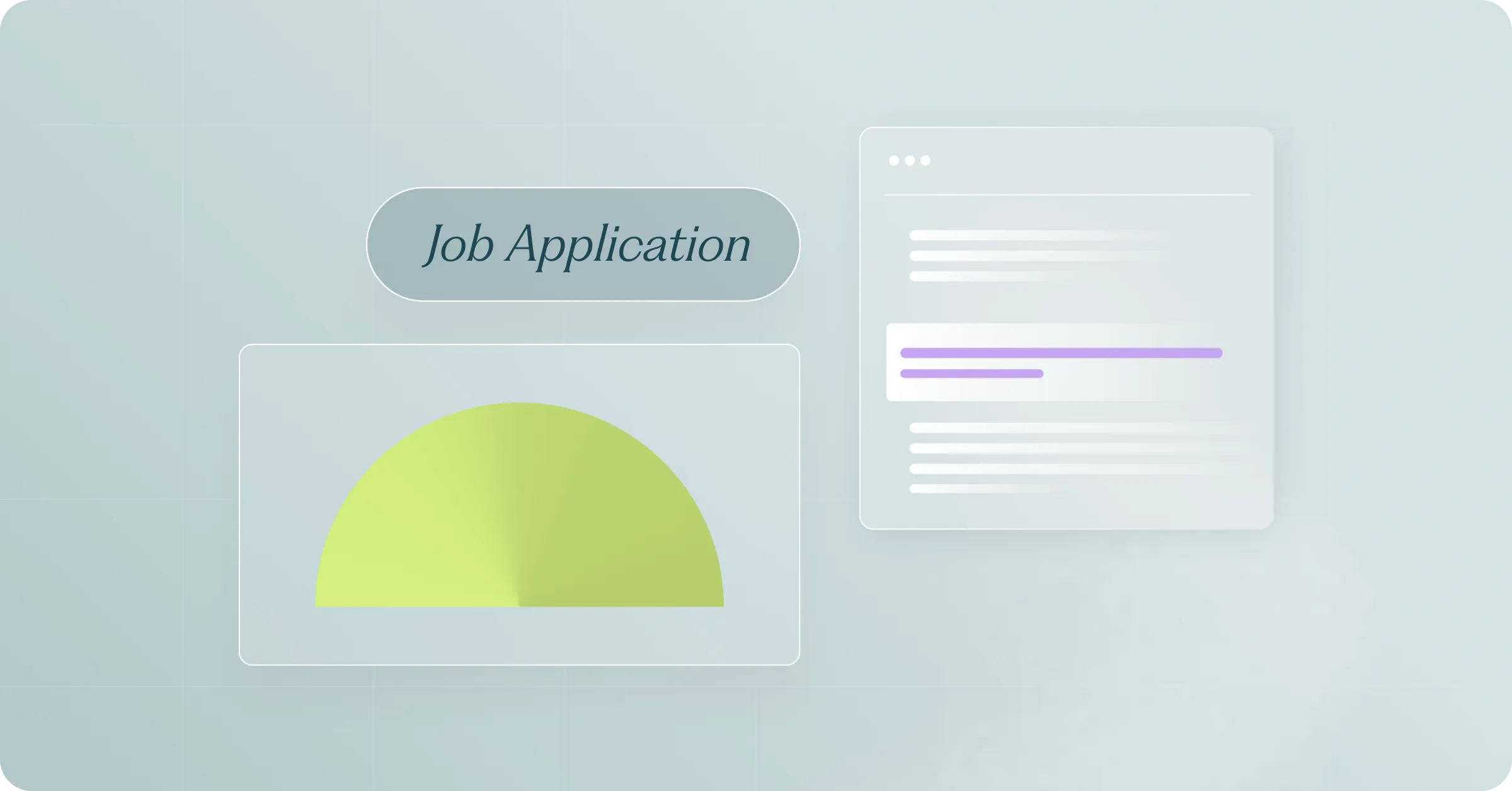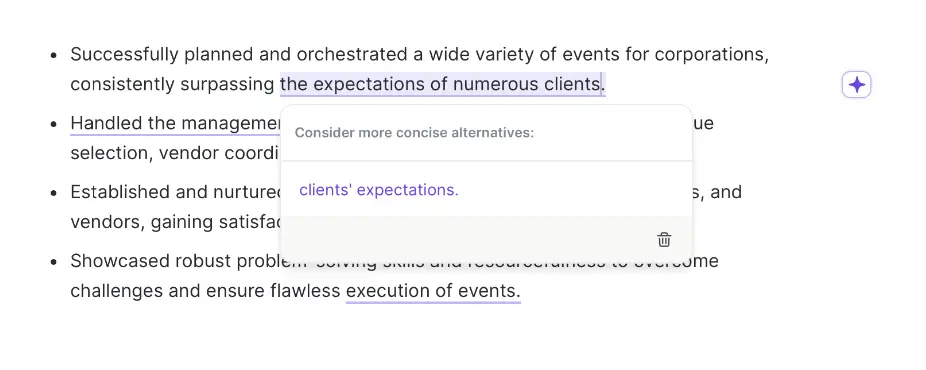9 Tips to Improve Your Job Application

54% of recruiters say that finding high-quality candidates is their top goal.
This means job-seekers need to prove they have the desired skills and experience to excel in a given role. And the best way to do this is through a stellar job application.
Only, assembling an impressive application is often easier said than done.
As a professional writer, I’ve applied for many roles across journalism and publishing — and in that time, I’ve discovered how to take a so-so application and turn it into one that shines.
In this article, I break down common job application elements, share tips on how to improve a job application, and provide a handy cover letter template.
.webp)
Parts of a job application
Before we dive in, let’s cover the main elements of a job application. Generally, it consists of an application form, a request for a resume and cover letter, and fields where you can explain your experience and other details that demonstrate your suitability for a role.
You’ll typically find the following sections in a job application:
- Personal information
- Education
- Work experience
- Company-related and competency questions
- References
How to improve a job application: 9 effective tips
Next, I’ll share nine tips to improve your job application so you wow hiring managers and stand apart from other candidates.
1. Carefully read the job description
Before applying for a job, review the job description. This ensures you understand what the role entails and helps you determine whether you meet the requirements.
Let’s say you're thinking about applying for a media strategist position. You see that the role requires you to have a “proven record of achieving sales goals across media channels” and “extensive knowledge of customer relationship management software.”
If you lack these qualifications, you should consider applying to another position that better fits your work history. That way, you can highlight relevant skills and experience, increasing your chances of advancing in the hiring process.
2. Research the company
By researching the company you’re applying to, you can better explain in your application how your skills, qualities, and achievements align with its mission and goals.
During your research, focus on five key areas:
- Mission statement
- Company values
- Products and services
- Current initiatives and projects
- Company leadership
You can find this information on the organization’s website. However, to get a full picture of a company, you should also explore its social media platforms, newsletters, customer and employee reviews, and recent news coverage.
3. Follow directions
In the early hiring stages, recruiters and hiring managers often reject candidates who don’t follow application instructions. This is because attention to detail and the ability to follow directions are important qualities for everyone to have.
So, if you want to make it to the next round, carefully follow all instructions around submission materials, naming conventions, and other items in the job application.
For example, lifestyle media brand The Everygirl specifies what applicants should include in their job application for a social media editor position: a resume, social media handles, ideas for content, and more.
The brand also instructs candidates on how to label their applications and the email address they should send it to.

4. Tailor your resume to the position
Your resume should align your skills and experience with those outlined in the job description.
You can show this overlap by using specific keywords. This is important, as many employers use an applicant tracking system (ATS) to eliminate applications that lack key information.
Consider the following job description for a content creator position. If you were applying for this role, you’d include keywords like the ones in bold:
- Create video and image content for Instagram, Facebook, and TikTok.
- Write clear and compelling social media copy.
- Optimize content for SEO to improve search engine rankings.
- Design attention-grabbing infographics using Canva.
For example, you might add to your resume a line such as, “Wrote SEO-optimized social media copy.”
5. Use numbers to illustrate your impact
Recruiters want to know more than what you did at your last job. They want to see how your actions impacted the company.
Numbers give them this information. When you use figures and percentages in your resume, you show recruiters that you can achieve measurable results for their organization.
Ariella Despins, former career support director at career advice site Work It Daily, suggests answering four questions to effectively incorporate numbers into your resume:
- How much?
- How many?
- How often?
- How long?
For example, a project coordinator might craft their resume points as follows:
- How much: “Implemented a new project tracking system, increasing workflow efficiency by 20%.”
- How many: “Trained 10 group members on project management best practices.”
- How often: “Generated progress reports for senior management twice a month.”
- How long: “Led a project team for six months, meeting key project milestones on time.”
6. Create a custom cover letter
Your cover letter should explain why you’re a good fit for the position and what attracts you to the company.
This is where the research you conducted earlier comes in handy. Connect what you learned about the organization and its culture to your qualifications and achievements.
As an example, let’s say the company you’re interested in values innovation and initiative.
In your cover letter, you could show that you embody these values by explaining how you introduced your previous employer to a cutting-edge productivity tool and helped the company integrate the software into its workflow.
7. Use proper formatting
Improperly formatting your resume and cover letter can indicate a lack of professionalism. So, make sure you check these key elements while formatting:
- Length. Keep your resume to one page and your cover letter to two to four paragraphs.
- Margins. Set your margins to one inch on all sides for both documents.
- Spacing. Use 1 to 1.15 line spacing for both documents. Also, leave a blank space between each job position on a resume and in between cover letter paragraphs to break up text.
- Structure. Your resume should feature sections for your work experience and bullet points for job duties. Meanwhile, your cover letter should tell a story about your qualifications and achievements using full paragraphs.
- Font and font size. For both documents, choose popular, easy-to-read fonts like Times New Roman or Arial in sizes 10 to 12.
- File format and name. Submit your resume and cover letter as PDFs to ensure consistent layout and formatting across devices. (But be sure to check that the company accepts PDF uploads!) Unless the company notes otherwise, include your first and last name and either “resume” or “cover letter” in the file name.
8. Provide thoughtful answers
Many job applications will ask you to answer specific questions — similar to ones you might encounter in a job interview.
Hiring managers assess your application answers for insight into your skills, experience, personality, and decision-making process. Therefore, you should craft thoughtful responses that allow recruiters to evaluate your character and how you’d respond to a given situation.
One approach is to use the “STAR” method. When using this method, you describe the “Situation” you faced, the “Task” you needed to achieve, the “Action” you took to address the situation and accomplish the task, and the “Result” of your actions, as well as lessons learned.
For example, here’s how a journalist might use the STAR method to answer the question, “Tell me about a time you failed.”
Situation:
As an education writer at a newspaper, I was assigned a story about a new academic department at a local college.
Task:
As part of my reporting process, I interviewed faculty within the new department but couldn’t get in touch with key decision-makers. I realized I needed more time to secure interviews to tell a complete story.
Action:
I explained the issue to my editor, requested an extension, and apologized for the inconvenience. He kindly granted the extension.
Result:
I conducted the necessary interviews and completed the story within the extension window. This experience taught me to create a plan for handling interview scheduling challenges. That way, I can always submit future stories on time.
9. Proofread
After completing your application, carefully review it for errors. As you proofread, pay close attention to:
- Facts and figures: Incorrect dates, names, or job titles.
- Spelling and punctuation: Typos, misspelled words, and missing/misused commas or periods.
- Clarity and concision: Wordy sentences, redundancies, and vague job responsibilities.
- Layout: Dense text, inconsistent spelling, or not enough white space.

Job application cover letter template
To help you get started with your job application, I've created a cover letter template you can use.
Simply fill in your personal information, and be sure to tailor the letter to the company and the position.
Conclusion
If you want to craft a great job application, you need to master the basics — and then go the extra mile.
Recruiters expect you to format your materials correctly and follow application instructions, so prioritize nailing these. Then, impress recruiters further by tailoring your resume to the company and position, customizing your cover letter, and providing thoughtful application answers.
To take your job application even further, check out our article on creating an effective personal statement.
FAQs
How do I fill out a job application with no experience?
If you lack experience in a particular field, highlight transferable skills you gained in school, as an intern, or through experience in other industries. For instance, someone applying for an entry-level web designer role could emphasize the graphic design skills they developed as the social media manager for a college club.
How can I increase my chances of getting hired?
You can increase your chances of getting hired by tailoring your job application to the position, using numbers on your resume to demonstrate your impact in previous roles, and properly preparing for the job interview (e.g., practicing your responses to interview questions).


.webp)
.webp)
